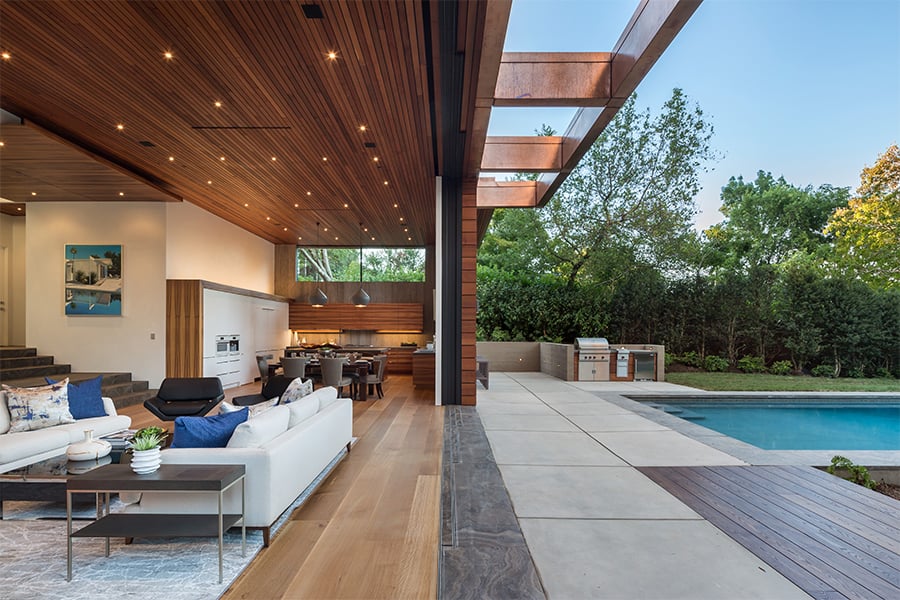6 tips for selecting the right big door
Indoor/outdoor living is on the rise, and big doors make it possible. BUT, they’re also major investments, which is why you want to get the details right — right from the start. We'll explain how!
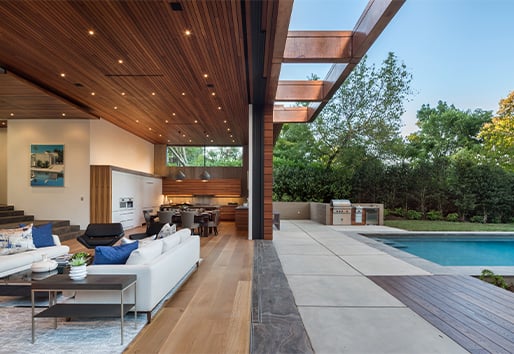
Doors that open up an entire wall pave the way to an indoor/outdoor lifestyle, and there’s an option that will work for every home. To choose the right one, it’s important to understand size, performance, and configuration. Selecting a door collaboratively — with the builder, architect, and homeowner — will ensure the best results.
Here are six things you need to know to select the right big door.
1. We've got your size
No matter if you’re looking for the largest moving glass wall system or specific functions like doors that work in corners or doors that can curve, chances are we’ve got what you need. Here are three options you should be aware of and the sizing available with all of them:
- Liftslide Door: Our premiere moving glass wall system, this door is precision engineered to open smoothly and easily, despite its monumental size. It can be designed for corner or curved configurations. It can be bi-parting. This is our largest option with sizes up to 16-feet tall and 60-feet wide, but it can also be scaled down to work as a Pass-Through Window. If you’re looking for the door with our highest PG certification, the Liftslide is your best option — the exact certification rating will depend on size and configuration.
- Folding Outswing Door: This option is made up of tall, narrow panels that accordion to the side when open. This top-hung door is easy to open and works great in a remodel, where the extra-thick walls required with other options might not be present. It comes with the option of either contemporary or traditional panels, and it can be sized up to 10-feet tall and 48-feet wide. It can also be used to create a pass-through window. This door is available with PG certification.
- MultiGlide™ Door: This oversized sliding door is easy to operate and available with automation. Doors can stack to the side or pocket into the wall, and panels are available in either traditional or contemporary panel styles. This door can be up to 10-feet tall and 50-feet wide or scaled down to create a Pass-Through Window. In addition, individual panels can be sized extra wide — up to 60 inches. This door is available with PG certification.
Want to see all these options side by side? Check out our big door comparison chart.
2. Pick the right sill for optimal performance
Your homeowner might not be familiar with PG certification ratings, but they’ll no doubt agree that they don’t want water inside their home. Help them understand that while their preference for a certain sill look or concern about stepping over the threshold are valid considerations, it is also essential that their door has the right level of performance. In certain climates, a flush sill might work fine, but in other places, like locations with wind-driven rain, for example, a more substantial sill will be the best defense against water in the home. Remind homeowners of local weather conditions as you work through this decision. Various options are available, including a PG-certified Liftslide Door with a flush sill and a PG-certified MultiGlide Door with a raised threshold sill. (In the following sections, we’ll share more suggestions about balancing client needs and preferences with performance requirements.)
PG certification ratings depend on door size and configuration, but here’s what you should know about your options:
3. Design can help accommodate a homeowner’s door of choice
In addition to the right sill, overhangs, porches, step-down thresholds, and the home’s orientation are aspects of design that can help make a big door work in any number of climates and under a variety of conditions. So, if a homeowner falls in love with a specific door, there are often options for performance at the level needed. But, these design approaches cannot be after-thoughts. The opening must be designed for the specific door and the correct sill right from the start. When the builder, architect, and homeowner work together to select a big door, it’s often possible to create a design that allows for the right level of performance while also satisfying the homeowner.
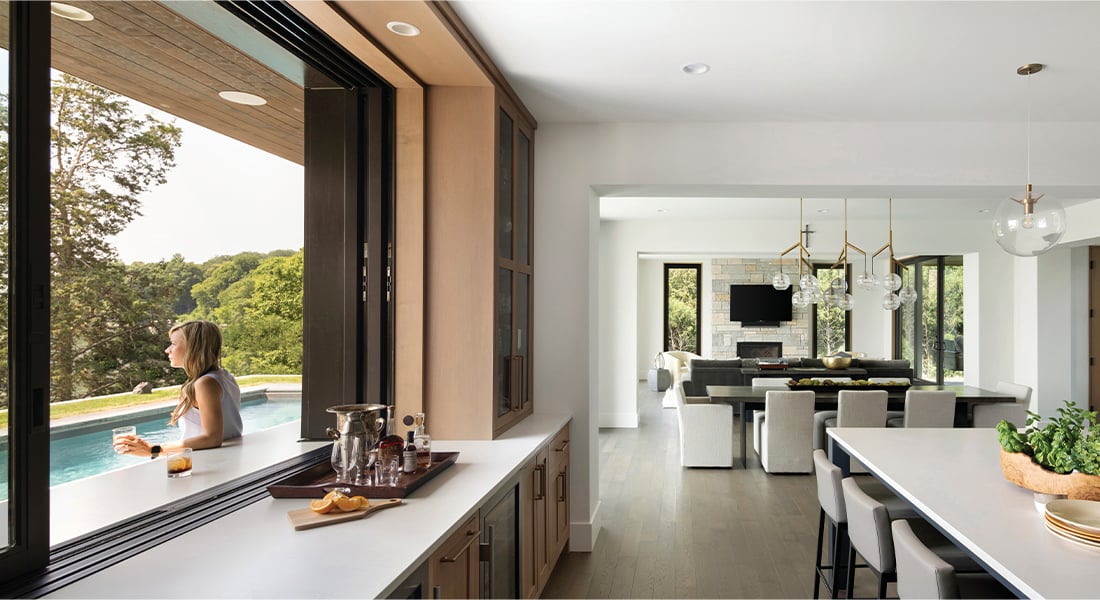
This Pass-Through Window was created using an automated, pocketing MultiGlide system. The right level of performance is built into the design with a large overhang and an on-floor drainage sill, which is sunken into the counter to create a flush sill effect. When you understand the rough opening and performance requirements, there are various ways to create the aesthetic your homeowner desires, but preplanning is essential to your success.
4. To get the rough opening right, understand the relationship between panels, tracks, and jamb depth
With both Liftslide and MultiGlide Doors, each panel runs on its own track. This means, the more panels selected, the more tracks required, which changes the jamb depth and pocket dimensions. This is why it sometimes makes sense to split the doors for a bi-parting opening or select wider panels so there are fewer of them — both options are available with these doors.
Don’t forget to include the insect screen when planning the rough opening. Our retractable insect screen runs along a single track and is available with the MultiGlide Door, but it must be ordered with the door. A paneled insect screen is available with the Liftslide Door, and again, it must be ordered at the same time as the door. It’s important to order the insect screen and door together so the track can accommodate.
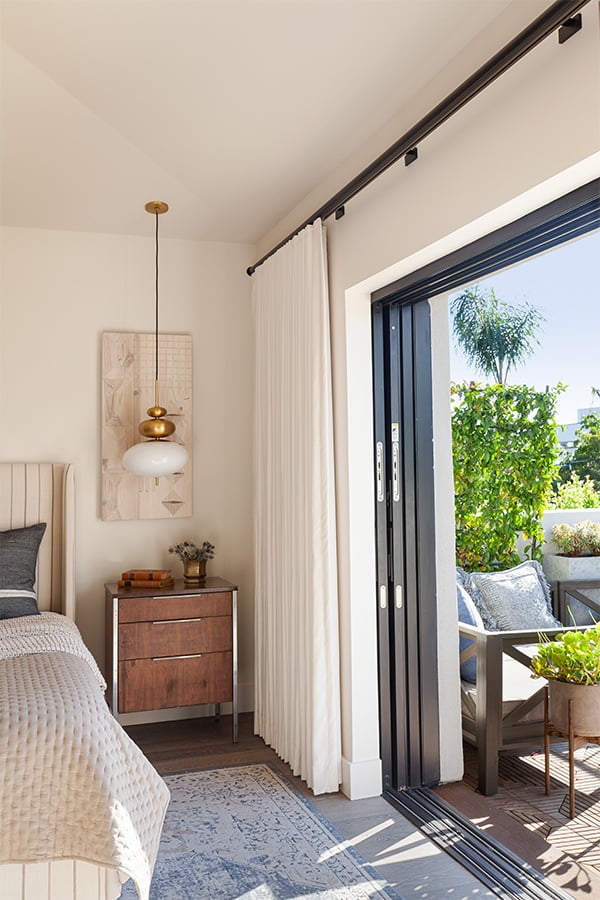
A two-panel, pocketing MultiGlide Door connects this primary bedroom with the balcony outside.
5. Get the handing right
Unfortunately, when a homeowner changes their mind about which direction their door opens after installation, the fix is a total replacement. Make sure the homeowner understands the flow of their space so they can make the right decision on handing. Again, this is why it’s important for builders, architects, and homeowners to work together on big door selection.
6. Have them try it before they buy it
Visiting a showroom is an excellent idea when picking out a big door. This will give your homeowner the chance to understand the aesthetics of their door and its ease of use. Here are four questions you should work through together:
- How easy is it for them to use the door? Have the homeowner try using the door. A Liftslide Door is engineered for very easy opening. Another option is automation, which is available for both MultiGlide and Liftslide Doors.
- Do they like the way it looks open? MultiGlide and Liftslide Doors stack to the side when open, which can partially obstruct the opening. One way to get around this is with pocketing — something you’ll of course need to plan for from the start. Alternately, Folding Outswing Doors accordion together for less obstruction of the opening.
- Do they like the way it looks closed? If a homeowner wants to minimize sightlines, fewer panels in a wider width can be a cost-effective way to do it while maintaining the desired rough opening size. MultiGlide and Liftslide Doors can both be sized with very wide panels, whereas the Folding Outswing Door has taller, narrower panels resulting in more vertical sightlines.
- How do they feel about the sill? As we’ve pointed out, sills are a major consideration that require balancing the homeowner’s needs and aesthetic preferences with performance requirements. Luckily, there are a variety of sill solutions available — for example, the patented flush drainage track available with the Liftslide Door. Find out more about sills on our big doors page.
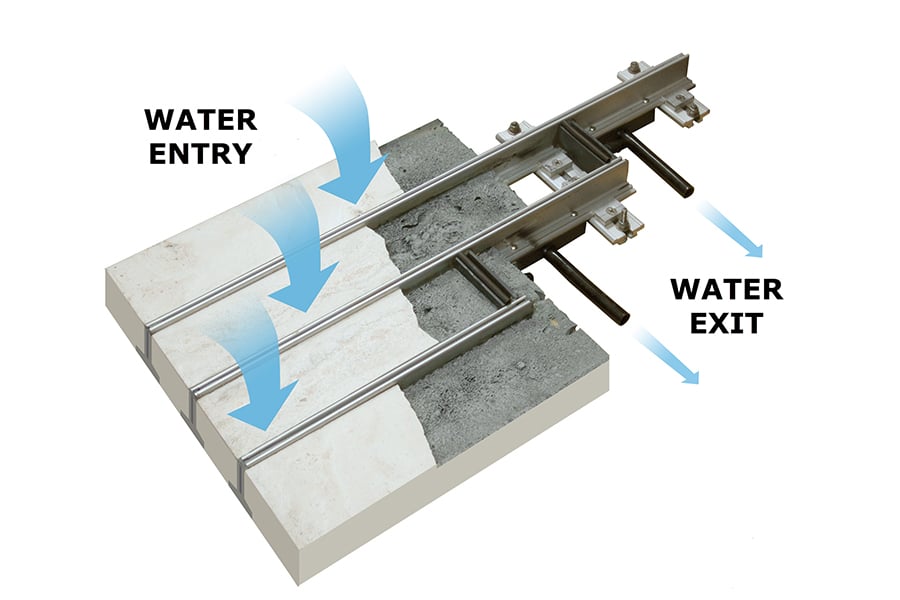
We’ve tested 12-foot-tall panel pocketing and non-pocketing Liftslide systems that meet Florida and Hallmark Hurricane Rated requirements using this patented full drainage track. The flooring used in both test systems was a smooth surface at exactly 3/16” below the top of the track, extending into the pockets.
Up next: Learn about all of our big doors or check out our sizing tools.
